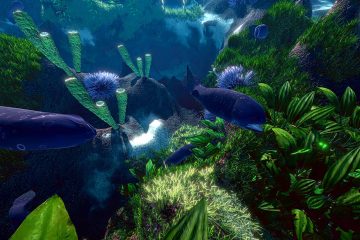July / August 2020 Newsletter
We hope you’ve been having a great summer in these strange times. It’s time for the July & August newsletter for Ecosystem! Over the past couple of months, lots of attention has been put into solving problems involving creating stable ecosystems with apparent trophic food chains, and there have been some surprising emergent results from testing of these improved systems. Let’s start by talking about the relationships between predators and their prey, and how difficult it is to achieve a balanced, sustainable system that can last long term.
Predators & Prey
As things stand in the current demo, it is very difficult to produce a stable system of balanced predators and their prey. In Ecosystem’s accelerated evolutionary environment, the best swimmers tend to very quickly outcompete all other similar lifeforms and quickly cause them to go extinct, leading to a lack of diversity and just one or two species that are dominant. After that, a predator-prey relationship is difficult to keep stable without one or both going extinct within a small number of generations.
Lots of the recent work has concentrated on addressing this. With the improved balance, having a stable relationship between multiple trophic levels of predator and prey is now quite possible! Apex predators – dominant predators that themselves have no natural predators – can now very much be a thing. Rather satisfyingly, the population counts now fit an approximation of the Lotka-Volterra equations that are useful for modelling predator-prey relationships in the real world.
Vision Simulation
A large recent change to the game is that creatures must now explore their environment to learn about it, rather than just having all of the information available to them from the get-go. There is now a vision simulation for each creature which only gives it limited information about the ocean world that it lives in. Now, if a creature is to detect another (be that a mate, prey, or a predator) there is a check in place that must first be passed – it takes into account things such as light level, motion and a comparison of the creature’s skin to the background behind it. The background could be plants, corals, terrain or open water.

The pigment of creature skin is already part of the evolution simulation, but you can see how this major change adds real selection pressure for creatures to be camouflaged. It opens the path for creatures to take advantage of caves, lurk among plants, and disguise themselves in any number of other ways to keep them hidden.
Unforeseen Consequences
Creature eggs, up until recent changes have been made to the unreleased build, would instantly spawn new creatures in the player-defined nurseries on the ocean bed. With the addition of ocean currents (see the previous newsletter for details on how this fluid simulation works) eggs are now carried off to distant locations and settle wherever they drift to. Nurseries are now more ‘natural’ in that they emerge from the other game systems working together. However, this caused an unexpected problem: there were now mass die-offs just a few generations in. This was a mystery indeed – what was the cause?
When a new species is spawned, the first few generations do not need to feed as per the simulation’s rules, the idea being that they subsist on microscopic organisms in the water. What this means practically is that there’s no selection pressure to reach food, they just have to be able to swim. The older nursery system made sure that creatures spawning in them were near the ground, and so had an advantage if they could navigate the terrain well.

However, in the newer system, the first few generations were adapting to the wider spaces of the open ocean, and when the time came for later generations to swim towards the ocean bed to forage, they were getting stuck on terrain they were not adapted to traverse. Making fertilised eggs sink slightly faster was the solution to this, so that the early generations had a chance to interact with floor structures. It wasn’t a bug, but an unforeseen consequence of the evolution simulation working in unexpected ways. It’s a rather mind-blowing example of how a seemingly tiny thing can have such wide-ranging implications in an evolutionary system!
Creature-Eye View & Seeing Seeds
A fun recent addition has been the inclusion of a ‘creature-eye view’, whereby you can select a creature and see a camera representing what they’re looking at. It’s not a headline feature but it is rather mesmerising to be able to see precisely what your creatures are focusing on! Another recent change is that plants and corals spread across the terrain more gradually, and there is now a visualisation of seeds being released to give the player a better idea of what is going on.
That concludes our round-up of recent work on the project. The game is now starting to feel like a true Ecosystem, with complex relationships between many systems producing emergent qualities that are greater than the sum of their parts – many of which are unpredictable (in a good way) even from a game design point of view. Hopefully you’ve enjoyed this insight; keep an eye on the Ecosystem social media (Twitter and Facebook) for weekly screenshots, videos and more regular news on the project!



3 Comments
Person111 · October 28, 2020 at 1:33 pm
Nice
Tom · October 28, 2020 at 3:52 pm
Thanks!
Person111 · October 28, 2020 at 5:14 pm
Oh, I didn’t know the messsage got through, it said that I already sent the message. Anyways, what I wanted to say is that: I think that the game has made some great progress, I love the game to bits and I honestly think you’re doing an amazing job, great work!